★ Molecular Advanced Functional Materials and Their Applications
Team Introduction
Our team is dedicated to research at the forefront of science and technology and interdisciplinary fields, focusing on organic polymer luminescent materials and devices, intelligent responsive organic polymer optoelectronic functional materials, and the industrialization of high-performance polymer materials. Over the past five years, our team members have achieved significant results in the research field of organic polymer advanced functional materials and their applications. These achievements include the publication of over 90 high-level academic papers, with more than 90 papers indexed in SCI; leading 12 national/provincial research projects; obtaining 36 authorized invention patents; and receiving awards such as the First Prize of Guangdong Province Natural Science Award and the 16th Ding Ying Science and Technology Award of Guangdong Province.
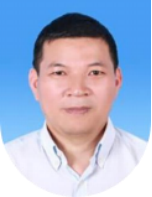
Team Leader
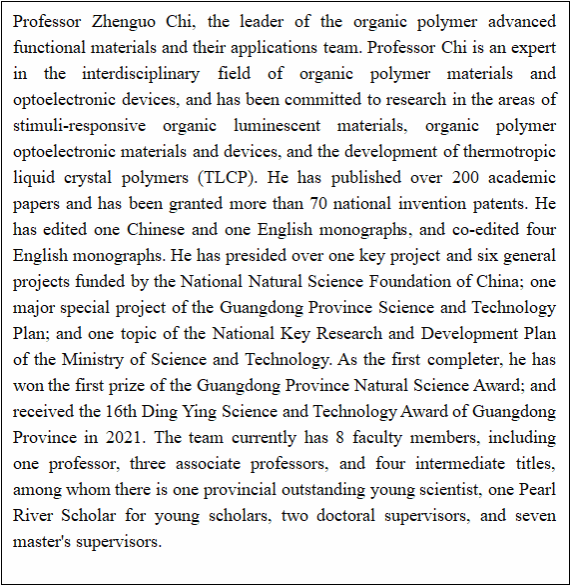
Research Areas:
1. High-Efficiency OLED and PLED Luminescent Materials and Devices
We have developed high-efficiency luminescent AIE-TADF organic polymer materials that combine aggregation-induced emission (AIE) and thermally activated delayed fluorescence (TADF) to address the issue of aggregation-caused quenching (ACQ) in luminescent molecules. By using AIE-TADF materials as the emissive layer and employing non-doping device fabrication processes, we can achieve high-efficiency OLED and PLED luminescent devices, which have significant application prospects in the fields of display and lighting.
2. Mechanical Stimulus-Responsive Organic Luminescent Materials
We have developed a range of mechanical stimulus-responsive organic luminescent materials that can emit light directly or change their emission color under the influence of external forces. These include fluorescent materials, TADF materials, and long-afterglow materials. Such stimulus-responsive smart materials have potential applications in fields such as anti-counterfeiting, information storage, and micro-stress sensing.
3. Thermotropic Liquid Crystal Polymer Materials
Thermotropic liquid crystal polymers (TLCP) possess characteristics such as high strength, high modulus, heat resistance, low moisture absorption, ultra-low dielectric constant, high flame retardancy, corrosion resistance, radiation resistance, microwave transparency, and vibration absorption. They are widely used in high-tech fields such as electronics, aerospace, national defense, and fiber optic communications, as well as in various industrial sectors of the national economy, including automotive, machinery, chemical, medical devices, and sports equipment. Our team has developed two major classes of TLCP materials--fully aromatic polyesters and polyester amides, which can be used for the preparation of plastics, films, and fibers, and are applied in areas such as precision electronic connectors, high-speed high-frequency communication substrates, and high-strength fibers.
4. Fine Chemicals Development
Committed to the research and development of fine chemicals, including the development of microelectronic encapsulation materials and electroplating auxiliary materials, we have already developed two products: "electronic ink screen frame sealant" and "high-density interconnect (HDI) printed circuit board copper electroplating solution additives," which have achieved performance levels comparable to similar imported foreign products. These products are currently in the pilot and industrialization promotion stages.
★ The Pharmaceutical Chemical Biology Team
Team introduction
Relying on the platform of the School of Pharmacy and Food Engineering, a team in medicinal chemistry and biology has been established. The team currently consists of six faculty members, including one professor, one associate professor, and four mid-level professionals; one doctoral supervisor and five master's supervisors.
Our team focuses on cutting-edge scientific issues in the pharmaceutical field, with chemical biology as the main research approach. We are committed to the development of new anti-tumour and anti-Alzheimer’s drugs through rational design of active lead compounds, efficient green synthesis and high-throughput activity screening. Additionally, organic small molecule compounds are used as probes to study their interaction with biological systems in order to reveal disease mechanisms and new drug targets. The team has made remarkable achievements in the field of medicinal chemistry and biology, including obtaining 7 national and provincial-level scientific research projects, publishing more than 50 high-level SCI papers, and obtaining more than 10 authorized invention patents.
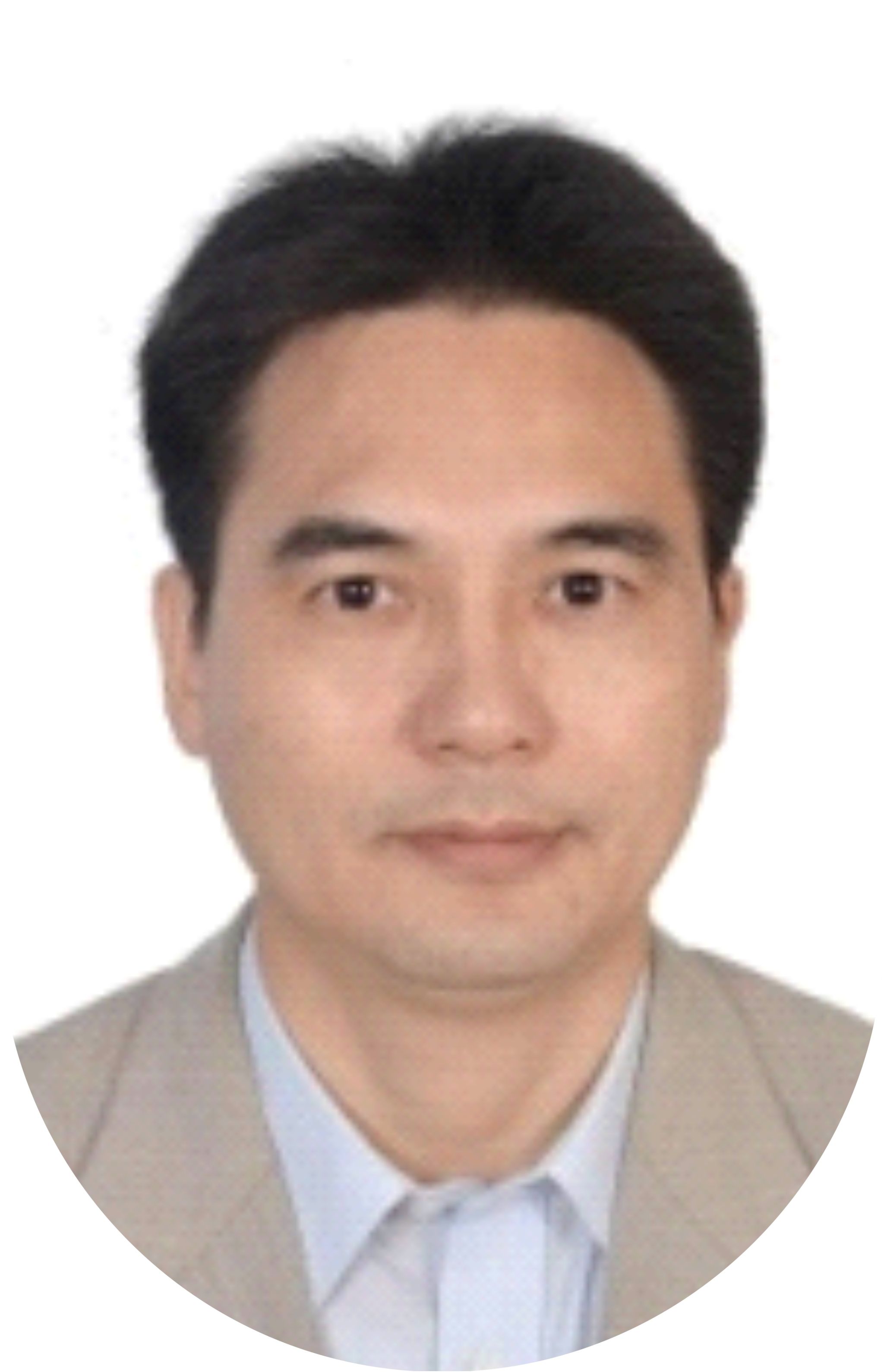
Team leader

Field of investigation
1. Research on the methodology of synthesis of pharmacologically active molecules
By utilizing advanced synthetic techniques, the research is conducted on efficient green synthesis, late-stage structural modification and optimization of pharmacologically active molecules. Corresponding compound libraries are established to provide new chemical entities with rich structural diversity and complexity for drug development to promote the development process of innovative drugs.
2. Efficient construction of drug-like small-molecule compounds and the study of the anti-tumor mechanism
Using the principle of rational drug design, we designed and synthesized drug-like heterocycles with potential biological activity and small molecule compounds with anion transmembrane transport activity, and systematically evaluated their anti-tumor activity, in order to discover small molecule drugs with significant anti-tumor activity.
3. Design and synthesis of new small molecule fluorescent probes, and research on the mechanism of disease occurrence and new drug targets
(1) Design of synthetic organelle-targeted fluorescent probe molecules for the identification and labeling of tumor-related markers, monitoring and regulation of ions inside and outside cells or organelles, as well as intracellular protein labeling and imaging under non-genetic modified conditions.
(2) Utilization of modern technologies such as synthetic chemistry, optical spectroscopy and biological imaging to deeply study the pathogenesis of Alzheimer's disease in order to discover new drug targets.
4. Screening of non-coding RNAs related to complex diseases based on Bioinformatics Data Mining
Using biological big data mining technology, we systematically screen non-coding RNA related with complex diseases in existing databases, so as to understand disease mechanisms from a new perspective and provide a theoretical basis for the development of new diagnostic and therapeutic strategies.
★ Water Quality Online Monitoring and Treatment Team
Team Introduction
The team aims at water quality monitoring and treatment. Focusing on water body remediation, the team has developed technologies such as membrane separation, advanced chemical oxidation, and microbial treatment. Based on these technologies, the team has conducted research and development of online water quality monitoring and treatment equipment, resulting in a series of innovative research outcomes. The team has published over 110 SCI papers in journals such as Environ. Sci. Technol., which have been cited more than 2000 times. They have obtained more than 20 projects including the General Program of the National Natural Science Foundation, with approved research funds exceeding 16 million yuan. The students they have guided have won over 20 awards, including the second prize in the 18th "Challenge Cup" National College Students' Extracurricular Academic Science and Technology Works Competition. The team members have received several scientific and technological awards as the first completers, such as the China Invention Patent Excellence Award and the second prize of the Innovation Award from the China Invention Association for "Environment-Adaptive BOD Online Monitor and Industrialization." The team currently consists of 10 faculty members, including 2 doctoral supervisors and 9 master's supervisors.

Team leader
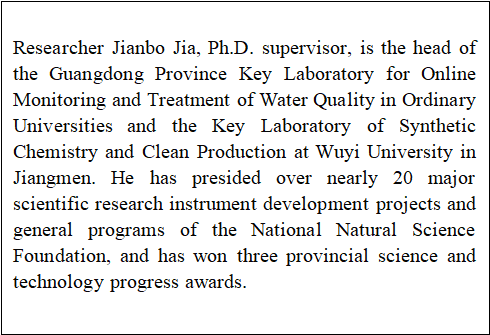
Research Areas
1. Physical Control of Water Pollution
Led by the application of membrane separation technology in the physical control of water pollution, the development of new types of two-dimensional material membranes represented by two-dimensional graphene oxide membranes is underway. The research focuses on fundamental issues in the application of membrane separation technology for the purification and reuse of high-salinity organic wastewater. The developed membrane separation performance surpasses the upper limits of traditional membranes, showing promising applications in water purification, chemical separation, and energy utilization.
2. Chemical Control of Water Pollution
Guided by the efficient control of emerging contaminants in water through photochemical oxidation processes, we focus on the control efficiency of emerging contaminants and the mechanisms of photochemical oxidation. We have established a novel system of photo-activated high-valent oxidants and successfully constructed a reaction kinetics model for the oxidation of emerging contaminants, elucidating the contribution of the main reactive species.
3. Development of Online Monitoring Technology and Equipment for Water Pollution
Facing the water quality monitoring and treatment industry, we engage in the research and development of online analysis methods and monitoring instruments for organic oxygen-consuming pollutants and inorganic ammonia in water quality based on environmental functional microorganisms. By utilizing environment-adaptive and self-acclimating oxygen-consuming microorganisms, we have addressed practical issues such as the 5-day duration for BOD measurement and the use of highly polluting reagents for ammonia nitrogen measurement. The various online water quality monitors we have developed have been applied in actual scenarios across multiple surface water and pollution source locations.
★ Luminescent Materials and Devices Research Team
Team Introduction
To accelerate the construction of a high-level science and engineering university, the Luminescent Materials and Devices Team has been established based on the luminescence platform. The research and development outcomes are primarily applied in fields such as intelligent lighting, LED display, temperature sensing, and photocatalysis.
This team focuses on the design and application of new fluorescent materials, research on all-inorganic perovskite quantum dot display materials, and research on carbon quantum dot luminescent materials, exploring cutting-edge technologies and interdisciplinary fields. Since its establishment, the team has achieved significant results in the field of luminescent materials, including the publication of over 100 high-level academic papers, with more than 80 papers indexed in SCI/EI; obtaining over 30 national/ministerial research projects; and being granted over 20 invention patents. The team has also received scientific research awards such as the 2019 Industry-University-Research Innovation Achievement Excellence Award and the first prize of the 2021 "Infinite Innovation" Jiangmen Science and Technology Award.

Team leader
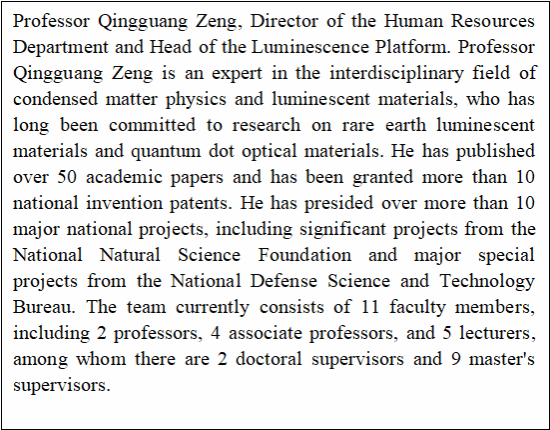
Research Areas
1. Research on Rare Earth Luminescent Materials
By leveraging the rich energy level structure and excellent luminescent properties of rare earth transition metal ions, we address issues such as high color temperature and low color rendering index in LEDs. We have developed high-performance rare earth and transition metal ion-doped phosphors, glass ceramics, and other luminescent materials, studied their structure-property relationships, and explored their applications in devices.
2. Quantum Dot Luminescent Materials
We explore the design and synthesis of all-inorganic perovskite quantum dots, structural regulation, luminescence mechanisms, and performance studies. By using theoretical calculations to explore the relationship between structure and performance, we aim to ultimately apply luminescent materials in white LED lighting devices, optoelectronic display devices, and photoelectric detector devices.
3. Carbon Quantum Dot Luminescent Materials
Aimed at the display and lighting fields, we focus on the application of monochromatic full-spectrum carbon quantum dot illumination. We have achieved the simple, large-scale, and stable synthesis of fluorescent carbon dot materials, breaking through the patent barriers of phosphor-based white LEDs, and realizing the application of rare-earth-free, low-cost white LEDs excited by blue light. Carbon dots possess unique structural and electronic properties, which allow them to serve as carriers for metal sites and synergistically activate persulfates to efficiently degrade organic pollutants, thus expanding their applications in photocatalysis.
★ Flexible Sensing Materials and Devices Research Team
Team Introduction
Leveraging the "Materials Science and Engineering" key discipline, the Guangdong Provincial Key Laboratory of New Materials and Components, and the Guangdong Engineering Technology Research Center for Flexible Sensors and Applications, the Flexible Sensing Materials and Devices Research Team has been established.
This team is dedicated to research in cutting-edge technologies and interdisciplinary fields such as flexible sensing materials and applications, flexible batteries, and flexible display devices.
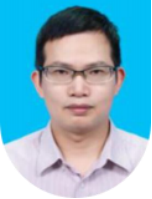
Team leader

Research Areas
1. Flexible Multifunctional Tactile Sensors
By constructing models of quantum tunneling mechanisms and impurity scattering mechanisms, we design and synthesize new types of carbon fiber materials that are cost-effective and have excellent stability. We invent a preparation technology for integrated temperature and stress sensors based on the radial pressure sensitivity and axial temperature sensitivity of carbon fibers, effectively solving the problems of difficult integration between flexible sensing materials and flexible substrates, as well as the single-function nature of sensing. This enables the realization of flexible multifunctional tactile sensors and the development of related application research.
2. New Flexible Energy Storage Devices
We explore the technology of synergistic energy supply between flexible energy conversion devices such as thermoelectric, piezoelectric, and solar photovoltaic devices and energy storage batteries. This aims to achieve a new type of flexible energy storage device that integrates energy collection, conversion, and storage, and to develop a power supply system for wearable electronic devices that is safe, low-energy-consuming, and has a long battery life.
3. Flexible Display Devices
We investigate the low-temperature preparation technology for high-quality buffer layers to achieve compatibility between flexible plastic and fabric substrates with display technologies such as electrochromic and electronic paper. We have mastered the high-density film encapsulation technology, which effectively isolates water and oxygen from eroding display devices, leading to the development of highly stable, washable, and wearable flexible display devices. This provides a high-quality human-computer interaction platform for wearable electronic devices.
★ Polymer Materials Intelligent Manufacturing Team
Team Introduction
Based on the platform of the Polymer Materials Intelligent Manufacturing Engineering Technology Research Center at Wuyi University, the Polymer Materials Intelligent Manufacturing Team has been established, which currently consists of 8 faculty members, including 1 professor, 2 associate professors, and 5 lecturers. Among them, there is 1 Pearl River Scholar, 1 doctoral supervisor, and 7 master's supervisors. Since its establishment in 2019, the team has achieved significant results in the field of new methods, new technologies, and new equipment for polymer material molding and processing. These achievements include the publication of 26 high-level academic papers, with 21 papers indexed in SCI/EI; obtaining 12 national/ministerial scientific research projects; being granted 18 invention patents; and receiving awards such as the second prize of the Guangdong Light Industry Federation Science and Technology Progress Award and the third prize of the China Light Industry Federation Science and Technology Progress Award.

Team leader
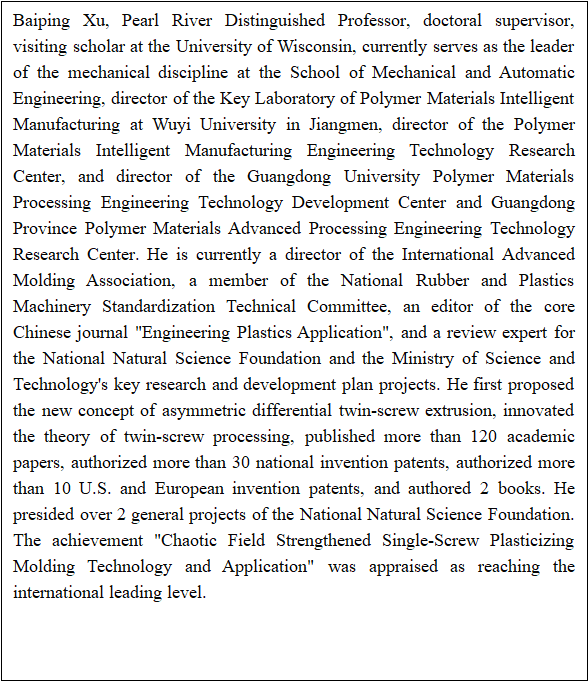
Research Areas
1. Polymer Materials Chaotic Field Processing Equipment and Intelligentization
Taking the processing mechanism of co-rotating asymmetric twin-screws as a research breakthrough, we explore intelligent manufacturing methods for key components, and study the solid conveying rules, melting mechanisms, and mixing mechanisms of polymer materials during processing under the action of chaotic flows.
2. Design and Preparation of Multi-dimensional and Multi-scale Functional Polymer Materials
We conduct research on the preparation technology of functional polymer materials under the action of chaotic flows; innovation in polymer processing methods under multi-field coupling; and design and processing of micro-scale flow channels.
3. Construction and Optimization of Intelligent Manufacturing Lines for Polymer Materials
We engage in innovative design of processing equipment and key components, innovative preparation and manufacturing of products, and the establishment of intelligent manufacturing demonstration platforms.
★ Textile Chemistry and Green Production Team
Team Introduction
Based on the platform of the Guangdong Provincial Engineering Technology Research Center for Functional Fibers and Textiles, the Textile Chemistry and Dyeing & Finishing Engineering Team has been established.
This team focuses on the research of green ecological textile materials, dyeing and finishing auxiliaries, fluorescent dyes, and other cutting-edge technologies and interdisciplinary fields. Since its establishment, the team has achieved significant results in the field of ecological and functional textiles research, including the publication of nearly 70 high-level academic papers, leading 56 projects at national and provincial levels, being granted 25 invention patents, winning one third prize in the field of natural science in Guizhou Province, and guiding students to win nearly 20 awards in provincial and above-level innovation and entrepreneurship competitions.

Team leader
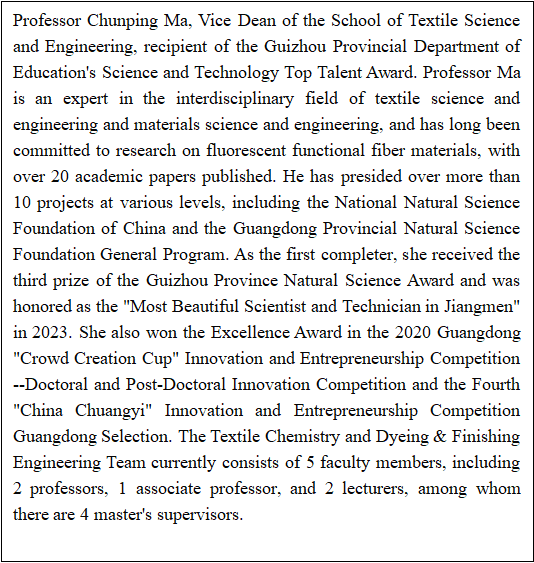
Research Areas:
1. Green Ecological Textile Materials
In response to the urgent need for high-quality development in the textile industry, we solve the moisture conduction response issue through interface modification and propose a framework that combines temperature control and unidirectional moisture conduction. This endows textiles with functions such as cool sensation, warmth retention, unidirectional moisture conduction, quick-drying, ultraviolet resistance, antibacterial properties, and wrinkle resistance, contributing to the "Double carbon" goals of the textile printing and dyeing industry.
2. Dyeing and Finishing Auxiliaries
Aiming at green dyeing and finishing, we focus on the development of new dyeing and finishing auxiliaries and technologies to meet the demands of green dyeing and finishing techniques.
3. Functional Fluorescent Dyes
We synthesize new types of fluorescent functional dyes, explore the synergistic mechanisms between fluorescent dyes and fibers, and prepare new smart fiber materials. We explore their applications in the fields of biomedicine, flexible fluorescent sensing, and luminescent devices. Additionally, we explore the ultrasensitive detection of pollutants in printing and dyeing wastewater and oil-water separation applications, aiding in the green production of printing and dyeing.
★ Natural Drug Development and Utilization Team
Team introduction
Relying on the Jiangmen International Innovation Institute for Health and the Guangdong Provincial Key Laboratory for the Development and Utilization of Food-Drug Resources, the Natural Drug Development and Utilization Team has been established.
This team focuses on cutting-edge technologies and interdisciplinary research in the discovery of natural active molecules, optimization of natural active molecule structures, innovative utilization of natural resources, and new methods for quality control and evaluation of natural drugs. Since its establishment, the team has achieved significant results in the field of natural drug research, including the publication of about 160 high-level academic papers, of which about 150 are indexed in SCI/EI; obtaining 14 national/ministerial scientific research projects; being granted 50 invention patents; and receiving multiple scientific research awards such as the second prize of Guangdong Province's Science and Technology Progress Award, the Excellence Award of Industry-University-Research Cooperation Innovation Achievement Award, and the first prize of "Infinite Innovation" Jiangmen Science and Technology Progress Award. The team currently consists of 10 faculty members, including 2 professors, 5 associate professors, and 3 lecturers, among whom there is 1 doctoral supervisor and 10 master's supervisors.
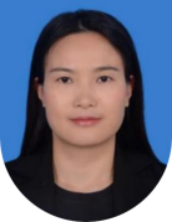
Team leader
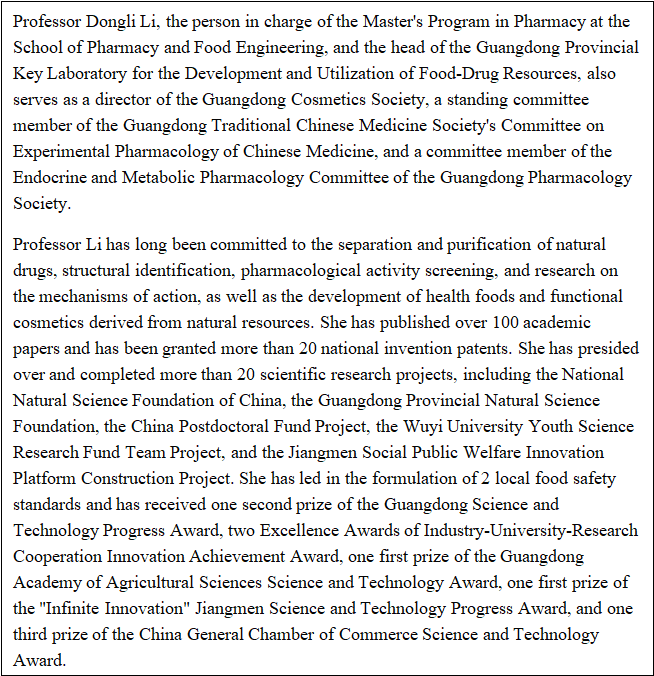
Research Areas
1. Discovery of Natural Active Molecules
Using in vitro and in vivo pharmacological research models, we conduct substance-based studies on medicinal plants from the Lingnan region, such as patchouli, cinnamon, kudzu, and gardenia, oriented towards new structures, new skeletons, and pharmacological activities, in order to discover new natural active molecules.
2. Structural Optimization of Natural Active Molecules
Led by natural active substances as lead compounds, we conduct systematic structural optimization and structure-activity relationship studies, with the aim of discovering original drug leads or drug candidate compounds targeting metabolic diseases such as obesity, diabetes, hyperuricemia, and conditions like cancer, inflammation, and vector-borne infectious diseases.
3. Innovative Utilization of Natural Resources
Based on the previous research of the pharmacological substance basis and mechanisms of action of natural resources, we conduct research on product formulations, product forms, and dosage forms according to the functions and characteristics of the raw materials, to develop food, health food, functional cosmetics, and public health products.
4. New Methods for Quality Control and Evaluation of Natural Drugs
Leveraging the advantages of artificial intelligence, machine learning, and image processing technologies, we develop and refine robust, accurate, and convenient new methods for spectral analysis. From a completely new perspective, we qualitatively and quantitatively analyze chemical fingerprint spectra and apply these methods to the quality control and evaluation of complex samples such as medicinal plants.
★ Biotechnology and Animal Model Research Team
Team Introduction
Based on Wuyi University and the South China Institute of Biomedical Large Animal Research, the Biotechnology and Animal Model Research Team has been established.
This team focuses on the construction of large animal models for major human diseases, the study of animal reproduction and embryonic development mechanisms, stem cell technology and stem cell therapy, gene editing technology research and gene therapy, organoid research and drug evaluation, and other cutting-edge technologies and interdisciplinary fields. Since its establishment, the team has achieved significant results in the field of biomedicine research, including the publication of over 50 high-level academic papers, with more than 40 papers indexed in SCI/EI; obtaining 3 national/ministerial scientific research projects; and being granted 2 invention patents.

Team leader
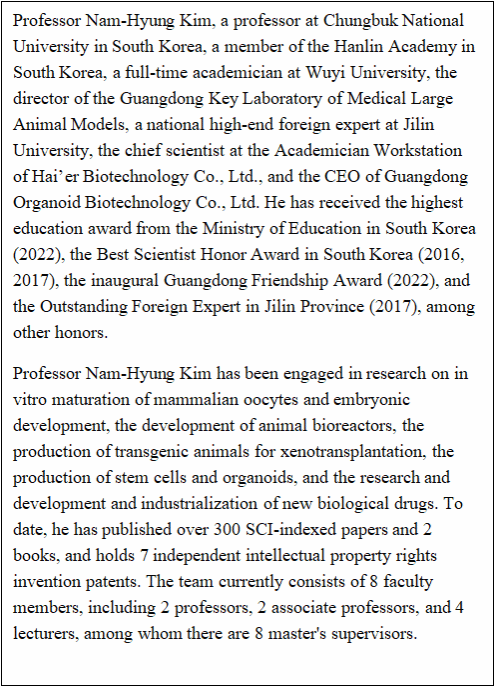
Research Areas
1. Stem Cell and Organoid Production
We have established methods for the rapid and large-scale preparation of cerebral organoids, high-speed and large-scale preparation methods for liver organoids, and methods for using them to screen drug efficacy and toxicity. Additionally, we have developed methods for the high-speed, large-scale manufacturing of midbrain organoids and methods for using them to screen neurotoxins and drugs related to dopaminergic neuron diseases.
2. Model Animal Production
We utilize transgenic technology to clone red fluorescent protein transgenic pigs, transgenic chickens, disease model transgenic dogs, tetracycline-regulated gene expression transgenic cloned pigs, and produce green fluorescent protein Genetically Modified Hanwoo based on the FIV lentiviral vector. Furthermore, we have achieved major results such as using transgenic animals for xenotransplantation to promote skeletal development and the development of an efficient reprogramming iPS cell system.
★ Qiaoxiang (Hometown of Overseas Chinese) Research Team
Team Introduction
Based on the provincial key discipline platform of "Qiaoxiang Culture and Heritage," and adhering to the purpose of "rooting in the hometown and serving the hometown," the team focuses on academic research and creative transformation of Qiaoxiang culture, writing academic papers on the land of Qiaoxiang and transforming potential cultural resources into actual social productivity.
The team has achieved significant results in the fields of Qiaoxiang history research, hometown cultural heritage protection, and the design and application of Qiaoxiang culture. Not only has the team successively completed the application for the World Cultural Heritage "Kaiping Diaolou and Villages" (2007) and the World Memory Heritage "Qiao Pi Archives: Overseas Chinese Remittance Letters" (2013), but it has also presided over the planning, design, and exhibition of a number of large cultural venues such as the China Qiaodu Overseas Chinese Museum. The team has also created the Qiaoxiang Cultural Heritage Cangdong Conservation Base and has received first prize twice, second prize twice, and third prize four times in the Guangdong Province Outstanding Achievement Awards in Philosophy and Social Sciences. The team has been honored with first-class merit twice by the province.
The team can provide professional training in aspects of Qiaoxiang culture, Qiaoxiang heritage, and intangible cultural heritage; planning and design of exhibitions and thematic planning for large cultural venues and spaces; planning and formulation of local social development plans for rural revitalization, cultural and tourism integration, and heritage revitalization; and policy consultation and think-tank services for overseas Chinese public services and overseas Chinese affairs.

Team leader

Research Areas
1. Academic Research and Creative Transformation of Qiaoxiang Cultural History
Based on academic research of hometown cultural history, a set of analytical frameworks, development ideas, and practical strategies grounded in scholarly research has been proposed to address various issues faced by local socio-economic development, such as rural revitalization, cultural and tourism integration, and the inheritance and protection of traditional culture.
2. Conservation and Revitalization of Qiaoxiang Cultural Heritage
Exploring a set of concepts, methods, systems, and practical pathways for the conservation and revitalization of Qiaoxiang cultural heritage that are suitable for the national and municipal conditions, providing innovative, replicable, and operable advanced successful experiences for the conservation and revitalization of Chinese Qiaoxiang cultural heritage.
3. Design and Application of Qiaoxiang Cultural Venues
Focusing on the cultural sector and cultural industry, and centering on the display design, thematic planning, and exhibition presentation of large-scale cultural venues in local society, the research results of hometown culture are creatively transformed and innovatively developed, providing spiritual sustenance and cultural products for the public.



